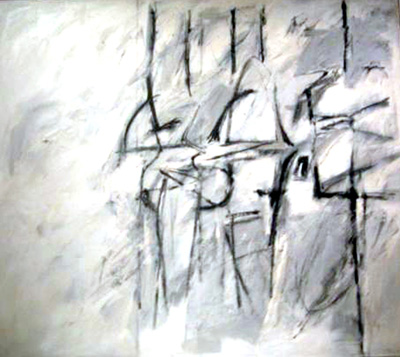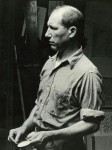
Jack Tworkov
Polish, 1900-1982 (active USA)
Sky, 1954
oil on canvas
59 1/8 × 67 1/8 in.
SBMA, Gift of Alexander M.Bing, Plymouth Foundation
1954.13

Photo of Tworkov 1950 ca.
In his Journal, March 6, 1960, Tworkov wrote, “I want to make paintings more noble, more real, more truthful than myself. The pictures should transcend me. I don’t want my pictures to speak of the world, or represent it or interpret it or reject it or hate it or judge it. I only want to bring something into the world that could attract to itself the scrutiny of imagining eyes. I don’t want something that merely represents or expresses me. I want something I have made. Not and object like a table with multiple uses and pleasures but something irreducible, unexchangeable, for the soul only-…”
“The hope that art reveals the whole man is frustrated-at best we show bits and pieces of ourselves- often ambiguous as if they didn’t belong to the same person.”
RESEARCH PAPER
Jack Tworkov was born in Poland in 1900. He arrived with his family in New York in 1913. He was a good student and was able to enter Columbia University as and English major. He became interested in painting through his sister, and by the late 20’s and early 30’s he was exhibiting his work in New York. Tworkov worked in the Easel Division of the WPA Federal Art project. It was here that he met and befriended Willem de Kooning, as well as other members of the New York school.
Tworkov was in his 40’s when he turned to Abstract Expressionism. Of all the New York School artists, his paintings were the least available for categorizing. He was a good writer, and he loved to talk about the world of ideas. This intellectual side shows through in his work-it is full of drama; it is self-interrogating; it allows for discovery through doubt; and it encourages evolution through self-criticism. Through his entire life Tworkov loved paint and the physical act of painting.
Though Tworkov was an abstractionist, he became opposed to that part of abstraction which is Expressionism. He defined expressionism as a “means of painting that not only erases the distinction between product and process-but endows the process itself with transcendental valor.” Of himself he said that he was a painterly painter but not a performer.
Tworkov felt that he “loved his painting” and that he experienced joy and fulfillment in the act of creation but he worried that the pleasure he felt in paint might prove narcissistic.
Tworkov was a 20th century European of Jewish descent, an urban intellectual. He knew first hand about alienation, assimilation, and displacement. He trusted his unconscious but did not “hand himself over to it”.
In technique Tworkov used a spontaneous free hand. His strokes move with and against the implied form. As time went on he abandoned figure and form for geometry and for implied form. His repertoire included diagonal strokes, hatched masses, concealed lines, and grids. Richard Armstrong thought Tworkov’s work spontaneous and strong of gesture and amongst the best in the New York School.
In the late 1950’s bold architectonic bands appear; the paint is applied in blunt directional strokes; linear elements counterpoise painterly technique and color is vividly chromatic.
By 1966, suspicious of too-beautiful or ingratiating color, Tworkov turned to an autumnal palette of muted grays, mauves, pinks, violets and oranges. His paintings became meditations, and there was a sense of landscape and solitude.
In 1968 and the early 70’s the legacy of Cezanne and Cubism became apparent. Some felt that the commitment to plane geometry in the late 60’s and 70’s should be seen in the context of minimalism, emphasizing as it does the simplified form with modules, series, and simple literal forms. Tworkov, however, was not a true minimalist. His love of paint was too great and his resistance to reduction too strong. Elizabeth Frank said that his was a painterly geometry and in his love for geometric form he found an inexhaustible source of ideas and possibilities.
In 1975 Tworkov began his Knight Series. These paintings were developed along the premise of chance movements in a set grid pattern. Tworkov integrated the paint and the linear structure in a masterful way.
The Indian Red Series which he began at roughly the same time is richly brushed. There are large areas of plain color and the format is large and expansive. Geometric complexity moves our eyes to the edges of the canvas.
Prepared by Margie Chelini, SBMA, Docent Council, December, 1993
Copied for the Web by Bernice Gelberg, SBMA, Docent Council, March, 2004
SBMA CURATORIAL LABELS
A founder of the New York School, Jack Tworkov’s gestural style typified the Abstract Expressionist movement of the 1950s. Characteristic of Tworkov’s creative efforts during this period, Sky is composed of lyrical calligraphic gestures that are rapidly executed and spontaneous in feel. Like his contemporaries, Willem de Kooning and Jackson Pollock, Tworkov sought to fill an empty canvas with intuitive responses, prompted by the process of painting rather than by recognizable subject matter. Tworkov abandoned Abstract Expressionism in the 1960s for a more deliberate style of geometric patterns and lines.
Study for "Sky” (c. 1953)—a preparatory drawing for Sky (1954)—is a recent gift of the Estate of Jack Tworkov honoring Alexander Bing and the Museum’s 75th Anniversary. Bing, who gifted the painting Sky to SBMA in 1954, was a devoted patron and dear friend of the artist. Produced in the early 1950s, Study for "Sky” provides a window into Tworkov’s working process.
- Ridley-Tree Gallery, 2016
